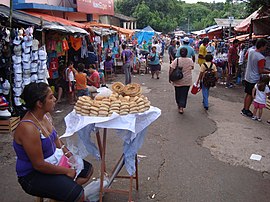Caacupé
| Caacupé | |
|---|---|
|
Coordinates: 25 ° 23 ′ S , 57 ° 8 ′ W
Caacupé on the map of Paraguay
|
|
| Basic data | |
| Country | Paraguay |
| Department | Cordillera |
| City foundation | 1770 |
| Residents | 19,131 (2002) |
| City insignia | |
| Detailed data | |
| surface | 145 km 2 |
| Population density | 132 inhabitants / km 2 |
| height | 196 m |
| Post Code | 3000 |
| Time zone | UTC −4 |
| Chipa seller in a market in Caacupé | |
Caacupé ( Guaraní Ka'akupe ) is the capital of the Cordillera Department of the State of Paraguay . The city of Caacupé has 19,131 inhabitants ( 2002 census ), the district of the same name 42,127. In 1982 the city had 9,151 inhabitants. The annual population growth is given as around 3%.
geography
The city, founded on April 4, 1770, is located about 50 km east of the state capital Asunción in a hilly landscape, which gave the department (Cordillera is Spanish for mountains) its name. The Ruta 2 road ( Mariscal José Félix Estigarribia ) runs through the village and connects Asunción, 53 km away, with Ciudad del Este and Brazil .
The climate is subtropical with an annual average of 22 ° C and an average annual rainfall of 1536 mm.
Place of pilgrimage
The place is of supraregional importance because of the cathedral Basílica de la Virgen de los Milagros , the episcopal church of the diocese Caacupé , located in its center . The central building covered by a large dome , the largest church and religious center in the country, began in 1945 and, after many construction delays, among other things due to lack of money, was only consecrated in 1988 by Pope John Paul II during his visit to Paraguay.
- Caacupé basilica
Every year in the week around December 8th ( Mary's Conception ), hundreds of thousands of Christians from all parts of Paraguay, but also from the surrounding countries, gather in the church and on the large forecourt. The pilgrims pay homage to the miraculous Virgin Mary . This is represented in the church with a 60 cm tall, blue robed statue of the Virgin Mary.
The statue and the pilgrimage go back to the miraculous rescue of a Guaraní Indian who converted to Christianity on the run from his pagan persecutors at the end of the 16th century. After calling Maria for help, he managed to successfully hide behind a bush. The place name is also derived from the term ka'aguy kupe or ka'akupe ( guaraní for "behind the bush" or "behind the herb"). In gratitude for his salvation, he made two statues of the Virgin Mary, one for the Church of Tobatí , the second, slightly smaller, for himself. The latter is now in the Cathedral of Caacupé. The high point of the pilgrimage is a large light procession in the evening.





